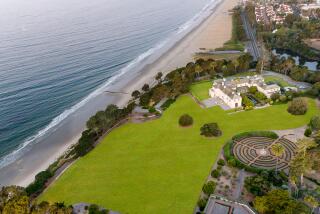The house where San Marino’s founding fathers...
- Share via
The house where San Marino’s founding fathers plotted their city’s future--prohibiting bars and gambling and apartment houses--is for sale.
It is also the homestead where “Old Blood and Guts” himself, Gen. George Patton, grew up and rode out to play polo and cowboy and swim in the nearby lake.
It sits on a knoll across from the Huntington Library, a three-story, 8,000-square-foot mansion built in 1910 by George Smith Patton II, the father of the general.
The home on Patton Court remains one of the few landmarks of a long-ago land purchase that helped create San Marino.
In 1854, Benjamin D. Wilson, who had served as Los Angeles’ first elected full-time mayor, bought 128 acres of what would become the heart of the 2,400-acre city of San Marino.
He built a lavish, two-story home with a wine cellar and tile roof, overlooking a lake. It cost a then-exorbitant $20,000. He surrounded his paradise with vineyards and citrus trees and called it Lake Vineyard.
Five years later, Wilson--for whom Mt. Wilson above Altadena is named, added to his holdings. He purchased the 14,000-acre Rancho San Pasqual, which covered much of what would one day be Pasadena, Alhambra, South Pasadena, Altadena and San Marino.
Wilson’s son-in-law and business manager, James De Barth Shorb, owned the nearby 500-acre San Marino Ranch, which he had named after his family home in Emmitsburg, Md. It would also become the name of the future city.
When high property taxes proved to be a headache, Wilson began selling large chunks to other ranchers.
But he kept Lake Vineyard. And it was there in 1884, six years after Wilson’s death, that Wilson’s younger daughter, Ruth, made a home with her new husband, attorney George Smith Patton II.
Within a year, Patton was elected Los Angeles County district attorney. He was 28. Also in 1885, Patton’s son and namesake was born. The father called him “The Boy.” His troops would later call him “Old Blood and Guts.”
The future World War II general grew up on the Lake Vineyard Ranch with such young friends as Ignacio (Nacho) Callahan.
Callahan, in a 1967 Los Angeles Times interview, remembered how he and young Patton would deliberately turn loose many of the ranch’s horses and mules. “Then Mr. Patton would order us to round them up and we would spend the whole night out” in a joyous roundup.
The two roamed the ranch on ponies--Patton’s was named Peach Blossom--played polo in the alfalfa patch below the house, swam in the lake, and tormented calves by grabbing their tails and hanging on for dear life as they scattered.
The elder Patton, after two terms as district attorney, retired to spend more time with a new friend and neighbor, railroad magnate Henry E. Huntington. Huntington had bought the San Marino Ranch from Shorb’s estate, and Patton and Huntington began making plans for San Marino.
Patton’s son graduated from West Point in 1909. The following year, the old house was torn down and the 20-room Patton mansion--the one for sale now--was completed.
It was in the new home’s comfortable basement that the elder Patton, Huntington and about a dozen other local ranchers secretly plotted San Marino’s incorporation when neighboring cities threatened to annex their prosperous farms.
They finally incorporated in 1913. San Marino’s first City Council meeting was held in the house, and the elder Patton became the city’s first mayor, serving 12 years. Before his death in 1927, he sold most of Lake Vineyard for subdivisions, except for 13 acres surrounding the mansion.
The lake, where local folks once swam and picnicked, gradually became a mosquito-infested swamp. It was later filled with dirt from excavations at the new Caltech and renamed Lacy Park in honor of Richard Lacy, San Marino’s second mayor. The only reminder of the lake is Pasadena’s Lake Avenue, once the main road to the Lake Vineyard Ranch.
At nearby Church of Our Savior in San Gabriel, where Gen. Patton’s parents were married and where Patton attended church, stands a bronze statue of the wild yet disciplined boy who grew up to become the most flamboyant and outspoken American general of World War II. He went into battle with profanity on his lips and ivory-handled revolvers on his hips. (Of reports that his revolvers were pearl-handled, he once said: “Only a pimp in a New Orleans whorehouse or a tinhorn gambler would carry a pearl-handled pistol.”)
By his standards he died a peaceful death, breaking his neck in a military vehicle crash in 1945, four months after the end of World War II.
The general’s only sister, Anne, never married and lived in her father’s house until her death in 1971. A developer then sold all but 1.5 acres to build the new homes that now surround the mansion.
Today, all this history can be yours. For only $3.9 million.
More to Read
Sign up for Essential California
The most important California stories and recommendations in your inbox every morning.
You may occasionally receive promotional content from the Los Angeles Times.













